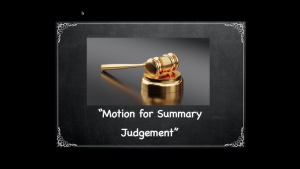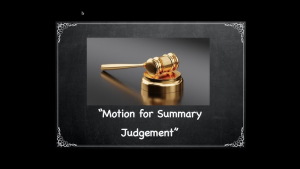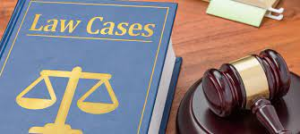INTRODUCTION

Navigating the labyrinth of legal jargon can be confusing, especially when 21qyou encounter terms like “motion for summary judgment.” Understanding this concept is crucial, whether you’re a lawyer, a paralegal, or simply someone interested in the legal process. In this article, we’ll delve into what a motion for summary judgment is, its objectives, and its place within the larger framework of civil procedure and court filings. The motion for summary judgment is a pivotal procedural tool in civil litigation. Its purpose is to facilitate the efficient resolution of disputes by allowing a court to make a final determination on a case without the need for a full trial. This essay explores the concept and significance of the motion for summary judgment, discussing its benefits, requirements, and implications within the legal system.
WHAT IS MOTION FOR SUMMARY JUDGMENT?
A motion for summary judgment is a legal document submitted to the court, seeking to expedite a legal case by skipping the trial phase. It’s based on the argument that there are no factual disputes to be resolved. Consequently, the judge should render a decision based solely on the legal issues. In essence, it’s a tool used in civil procedure to speed up litigation and save on costs.
THE PURPOSE AND SIGNIFICANCE OF SUMMARY JUDGMENT
At its core, the motion for summary judgment serves as a mechanism for disposing of cases where there are no genuine disputes of material fact, and the law clearly supports a judgment in favor of one party. Its primary objective is to promote judicial efficiency by preventing unnecessary trials, reducing litigation costs, and expediting the resolution of legal disputes. Summary judgment is a powerful tool that enables courts to allocate their resources more effectively while ensuring that only cases with legitimate issues of fact proceed to trial.
THE REQUIREMENTS FOR FILING A MOTION FOR SUMMARY JUDGMENT
To successfully obtain summary judgment, a moving party must meet certain legal requirements:
- No Genuine Disputes of Material Fact: The movant must demonstrate that there are no genuine disputes of material fact in the case. Material facts are those that are essential to the outcome of the lawsuit, and disputes about these facts must be non-existent or immaterial.
- Entitlement to Judgment as a Matter of Law: The moving party must establish that, based on the undisputed facts, they are entitled to judgment as a matter of law. In other words, the legal arguments presented must favor the movant.
- Supporting Evidence: The motion must be supported by admissible evidence, typically in the form of affidavits, depositions, documents, or expert opinions. This evidence should demonstrate the absence of genuine disputes of material fact and the movant’s entitlement to judgment.
WHEN IS A MOTION OF SUMMARY OF JUDGEMENT APPROPRIATE.
A motion for summary judgment is appropriate when certain conditions are met, and it can help streamline the legal process by avoiding a full trial. Here are the key situations in which a motion for summary judgment may be appropriate:
- No Genuine Disputes of Material Fact: The most critical condition for filing a motion for summary judgment is that there are no genuine disputes of material fact in the case. Material facts are those that are essential to the outcome of the lawsuit. If there are no genuine disputes regarding these facts, and the case essentially hinges on questions of law, then summary judgment may be appropriate.
- Clear Legal Entitlement: The moving party must show that, based on the undisputed facts, they are entitled to judgment as a matter of law. This means that the legal arguments and principles clearly favor the moving party. If the law is in their favor and there are no factual disputes, a motion for summary judgment is appropriate.
- Frivolous or Weak Claims: Summary judgment can be appropriate when one party believes that the opposing party’s claims or defenses are frivolous, baseless, or lack legal merit. It allows the court to dismiss such claims or defenses efficiently, sparing both parties the time and expense of a trial.
- Qualified Immunity (in Civil Rights Cases): In cases involving government officials, such as law enforcement officers, accused of violating an individual’s civil rights, qualified immunity may be raised as a defense. Summary judgment may be appropriate if the defendant can establish that they are entitled to qualified immunity as a matter of law.
- Breach of Contract Cases: In breach of contract cases, summary judgment may be appropriate if there is a clear and unambiguous contract in place, and the undisputed evidence shows that one party has breached the contract.
- Statute of Limitations: If the statute of limitations has expired on a claim, summary judgment may be appropriate. The moving party can argue that the claim is time-barred, and there is no dispute about when the statute of limitations began running.
- Res Judicata or Collateral Estoppel: Summary judgment may be appropriate if a party can demonstrate that the issues in the current case have already been litigated and conclusively resolved in a prior case (res judicata) or that a particular issue has been decided in a previous case and should not be relitigated (collateral estoppel).
- Default Judgment: If a party has failed to respond to a complaint or participate in the legal process, the opposing party may seek summary judgment by default, essentially arguing that the non-responsive party has admitted liability.
- Consent of Both Parties: In some cases, both parties may agree to file a joint motion for summary judgment when they believe that no genuine disputes of material fact exist, and they want to expedite the resolution of the case.
HOW TO FILE A MOTION OF SUMMARY JUDGEMENT
Filing a motion for summary judgment involves a formal legal process that varies depending on your jurisdiction and the specific court rules. While the exact procedure may differ, the following steps generally outline how to file a motion for summary judgment:
- Review Applicable Laws and Rules:
Familiarize yourself with the rules of civil procedure and any local rules specific to your jurisdiction. In the United States, for example, you should consult the Federal Rules of Civil Procedure or the rules of your state court.
- Prepare the Motion:
Draft the motion for summary judgment. It should include the following components:
Title: Include the name of the court, the parties involved, and the case number.
Caption: Provide a brief description of the motion’s purpose.
Introduction: Explain the purpose of the motion and the relief you are seeking.
Statement of Material Facts: Present a clear and concise statement of material facts that are not in dispute, supported by citations to evidence, such as affidavits, depositions, or documents.
Legal Argument: Present your legal argument explaining why you are entitled to summary judgment based on the undisputed facts.
Conclusion: Request that the court grant your motion for summary judgment.
- Gather Supporting Evidence:
Collect and assemble all the evidence you plan to use to support your motion. This may include affidavits, depositions, documents, or expert reports.
Ensure that the evidence is properly authenticated and relevant to the issues raised in the case.
- Serve the Motion:
Serve a copy of the motion, along with all supporting documents and evidence, on the opposing party or parties. Service must comply with the rules of civil procedure and any court orders regarding service.
Check the specific rules in your jurisdiction for the required method and timing of service. Typically, the opposing party is given a certain number of days (e.g., 21 or 30 days) to respond.
- File the Motion with the Court:
Submit the original motion, along with all attachments and supporting documents, to the clerk of the court where your case is pending.
Pay any required filing fees, or submit an application for a fee waiver if you qualify.
- Await the Opposing Party’s Response:
The opposing party will have a designated period to respond to your motion for summary judgment. They will typically file a written response that addresses the facts and legal arguments you presented.
- File a Reply (Optional):
Depending on your jurisdiction’s rules and the opposing party’s response, you may have the opportunity to file a reply to their response. This reply should address any new issues or arguments raised by the opposing party.
- Request a Hearing (if Necessary):
Some jurisdictions may require a hearing on the motion for summary judgment, while others may allow for a decision based solely on the written submissions. If a hearing is required or permitted, request one accordingly.
- Court Decision:
The court will review the motion, responses, and any oral arguments presented during a hearing (if applicable).
The court will issue a decision, either granting or denying the motion for summary judgment.
- Post-Motion Proceedings:
– Depending on the court’s decision, the case may proceed to trial if summary judgment is denied, or it may be concluded if summary judgment is granted.
Please note that the specific procedures and timelines for filing a motion for summary judgment can vary widely depending on your jurisdiction and the court in which your case is pending. Consult with an attorney experienced in civil litigation in your jurisdiction to ensure that you comply with all relevant rules and procedures. Legal counsel can provide valuable guidance throughout the process.
Differences Between Motion for Summary Judgment and Other Pleadings
Unlike complaints or answers, which initiate a case or respond to one, a motion for summary judgment aims to conclude it. It’s a unique tool within the realm of civil procedure and requires its set of legal documents and court filings.
Motions for summary judgment are distinct legal pleadings used in civil litigation and serve a different purpose compared to other types of pleadings commonly used in the legal process. Here are the key differences between a motion for summary judgment and other pleadings:
- Purpose and Function:
Motion for Summary Judgment: The primary purpose of a motion for summary judgment is to request the court to make a final determination on a case without the need for a full trial. It is filed when one party believes there are no genuine disputes of material fact, and the law supports a judgment in their favor. The goal is to efficiently dispose of a case.
Complaint and Answer (in a Lawsuit): A complaint is the initial pleading filed by the plaintiff to initiate a lawsuit. It sets forth the allegations and claims against the defendant. The defendant responds with an answer, admitting or denying the allegations and asserting any affirmative defenses. These pleadings are the starting point of a lawsuit and outline the basis of the legal dispute.
- Timing:
Motion for Summary Judgment: A motion for summary judgment is typically filed after the initial pleadings, such as the complaint and answer, and after the completion of discovery (the process of exchanging information and evidence between parties). It is usually filed when the parties believe that the case is ready for a judgment based on the evidence and legal arguments presented.
Complaint and Answer (in a Lawsuit): The complaint and answer are filed at the outset of a lawsuit, during the initiation of the case. They initiate the legal proceedings and set the stage for the exchange of information, pretrial motions, and, potentially, a trial.
- Content:
Motion for Summary Judgment: A motion for summary judgment includes a statement of undisputed material facts, supported by evidence, and legal arguments explaining why the moving party is entitled to judgment as a matter of law. It focuses on demonstrating that there are no genuine disputes of material fact in the case.
Complaint and Answer (in a Lawsuit): The complaint outlines the plaintiff’s claims, while the answer responds to those claims by admitting, denying, or asserting defenses. These pleadings set the framework for the legal issues and disputes to be addressed during the litigation process.
- Outcome:
Motion for Summary Judgment: The outcome of a motion for summary judgment can result in the case being decided in favor of one party without the need for a trial. If granted, it leads to a final judgment in favor of the moving party. If denied, the case proceeds to trial.
Complaint and Answer (in a Lawsuit): The filing of a complaint and answer initiates the lawsuit but does not determine the final outcome. These pleadings are the starting point for the litigation process, which may ultimately lead to a settlement, trial, or other resolution.
KEY CASE LAW AND PRECEDENTS


Several landmark cases have shaped the landscape of summary judgment motions, like Celotex Corp. v. Catrett and Anderson v. Liberty Lobby, Inc. These cases are frequently cited in court filings and have influenced how these motions are perceived and processed.
LEGAL SCHOLAR OPINIONS
Legal scholars often discuss the implications of using summary judgment motions, emphasizing the need for clear rules and guidelines. While some argue it’s a crucial part of civil procedure, others claim it can be misused to deny a fair trial.
CONCLUSION
The motion for summary judgment represents a critical juncture in civil litigation, offering the promise of swifter, more cost-effective dispute resolution. When employed judiciously, it can enhance the efficiency of the legal system, save valuable resources, and ensure that only meritorious claims proceed to trial. However, it is essential to strike a balance between expediency and the parties’ right to a full and fair adjudication of their claims. Summary judgment is a powerful tool that must be wielded with caution and in strict adherence to the established legal principles.
